| Columns Retired Columns & Blogs |
this is so iconic
I measured the Marantz Model 40n with my Audio Precision SYS2722 system. For the digital-input measurements, I used TosLink data and the HEOS app on my iPhone to play back test-tone WAV files on a USB stick plugged into the rear-panel port.
The Marantz's single-ended line inputs preserved absolute polarity at both the loudspeaker and headphone outputs. The volume control operated in accurate 0.5dB steps, and the maximum gain was 40.6dB at the loudspeaker outputs and 40.7dB at the headphone output. The power amplifier stage offered a fixed gain of 24dB. The input impedance at both the line inputs and the power amplifier inputs was 15k ohms at all audio frequencies.
The Model 40n's output impedance at the headphone output was a relatively high 320 ohms. The loudspeaker output impedance, including the series impedance of 6' of spaced-pair cable, was 0.1 ohm at 20Hz and 1kHz, increasing slightly to 0.12 ohm at 20kHz. The small-signal bandwidth was extremely wide, the response into 8 ohms (fig.1, blue and red traces) down less than 3dB at 200kHz. Into 2 ohms (green trace), the output was –3dB at 100kHz. Frequency-response variations into our simulated loudspeaker load (gray trace) were negligible. This graph was taken with the volume control set to its maximum ("100"); the excellent channel matching was preserved at lower settings of the control. The extended ultrasonic response meant that the Marantz's reproduction of a 10kHz squarewave featured very short risetimes (fig.2). Commendably, no overshoot or ringing was visible. The bass and treble controls offered a maximum boost and cut of close to 10dB (fig.3).
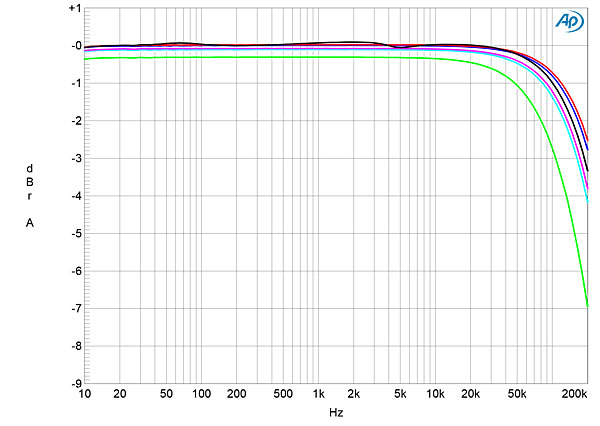
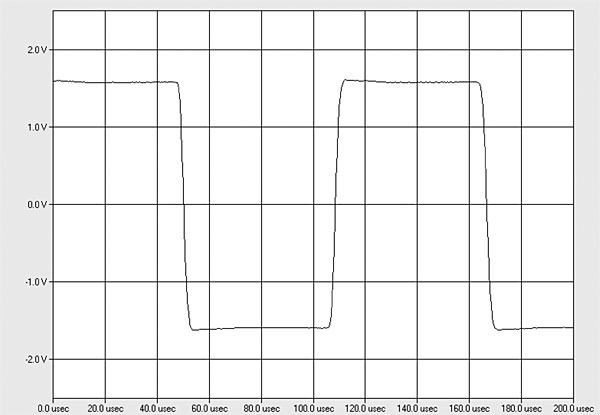
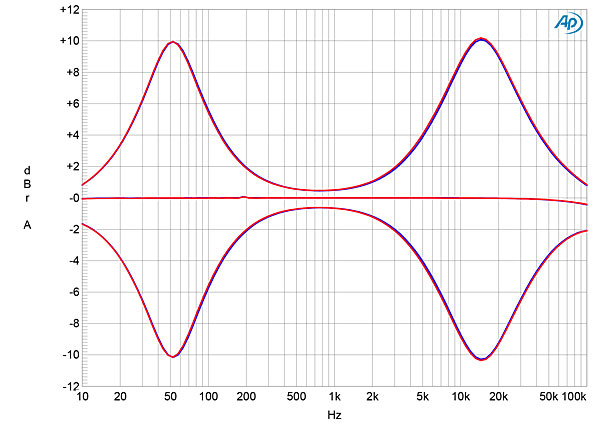
Channel separation was excellent, at 90dB in both directions below 3kHz and still close to 80dB at 20kHz. With the line inputs shorted to ground and the volume control set to its maximum, the Model 40n's unweighted, wideband signal/noise ratio was a good 71.7dB ref. 2.83V into 8 ohms (average of both channels). This ratio improved to 82dB when the measurement bandwidth was restricted to the audioband and to 84.7dB when A-weighted. While spuriae at the supply frequency of 60Hz and its harmonics were present in the amplifier's output (fig.4), their levels were all very low, even with the volume control set to its maximum.
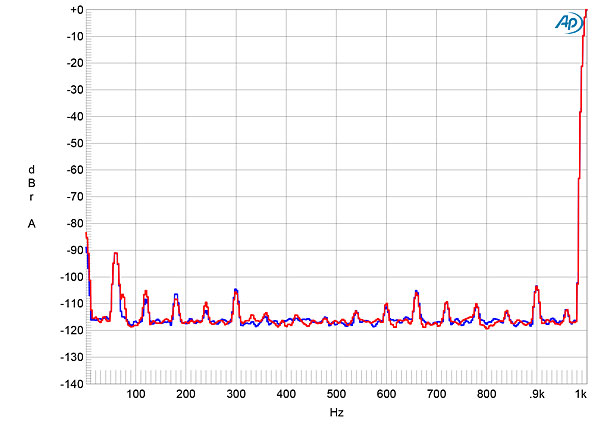
Marantz specifies the Model 40n's maximum power as 70Wpc into 8 ohms (18.45dBW) and 100Wpc into 4 ohms (17dBW). We specify clipping power as when the THD+noise reaches 1%. By that measure, and with both channels driven, the Marantz amplifier exceeded its specified powers, clipping at 74Wpc into 8 ohms (fig.5, 18.7dBW) and 120Wpc into 4 ohms (fig.6, 17.8dBW). I didn't test clipping power into 2 ohms, as the amplifier isn't specified into that load. (A notice on the rear panel says "Impedance: 4–16 ohms.")
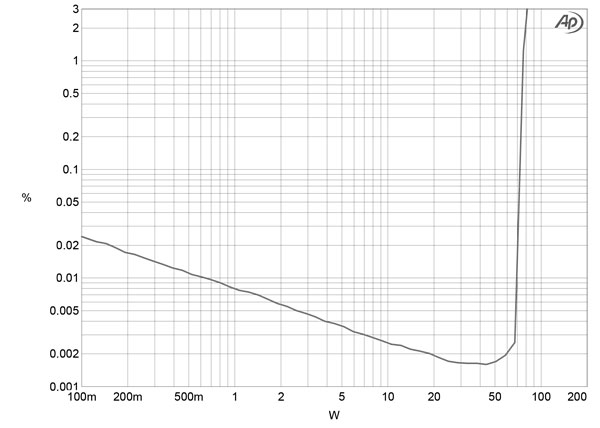
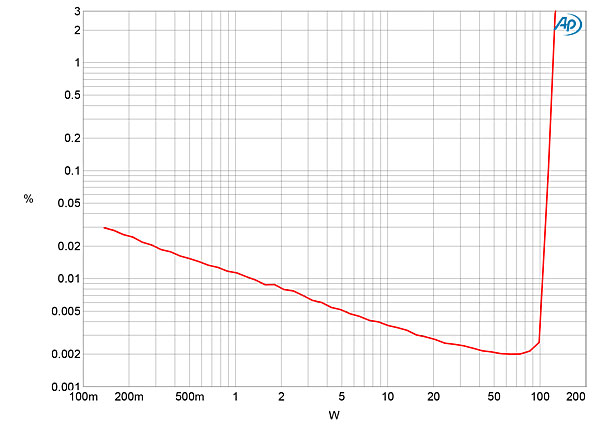
The distortion lies below the noisefloor at powers below a few tens of watts, so I examined how the THD+N varied with frequency at 20V, which is equivalent to 50W into 8 ohms and 100W into 4 ohms (fig.7). The distortion is very similar into both 8 ohms (blue and red traces) and 4 ohms (cyan and magenta traces), and while there is a slight increase in the top two audio octaves, the distortion is extremely low.
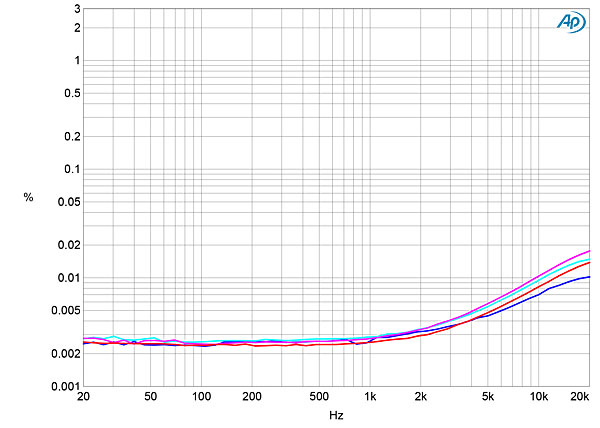
The distortion waveform at this output voltage was dominated by random noise, even when I averaged 32 readings (fig.8). Spectral analysis (fig.9) indicated that the second harmonic was the highest in level into 8 ohms, but at –103dB (0.0007%), this is negligible. At the same voltage into 4 ohms (fig.10), the third harmonic was now the highest in level but at close to –100dB (0.001%) is still negligible. Tested with an equal mix of 19 and 20kHz tones at 100W peak into 4 ohms, the intermodulation distortion products all lay at or below –90dB (fig.11).
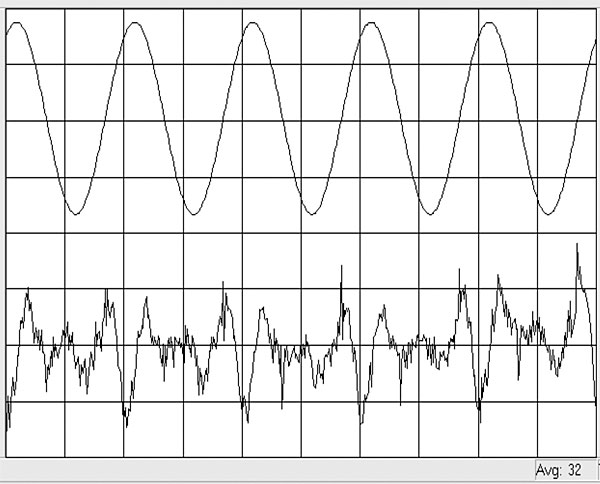
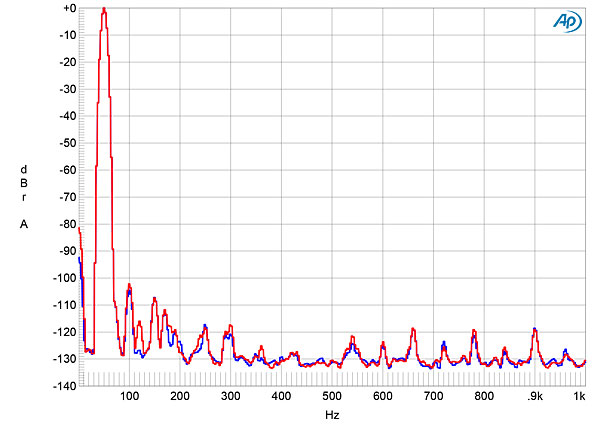
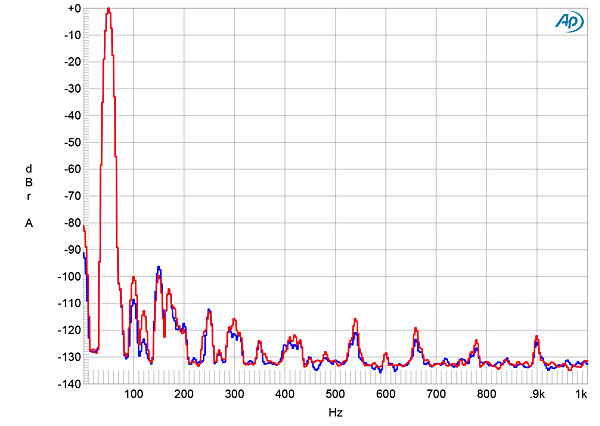
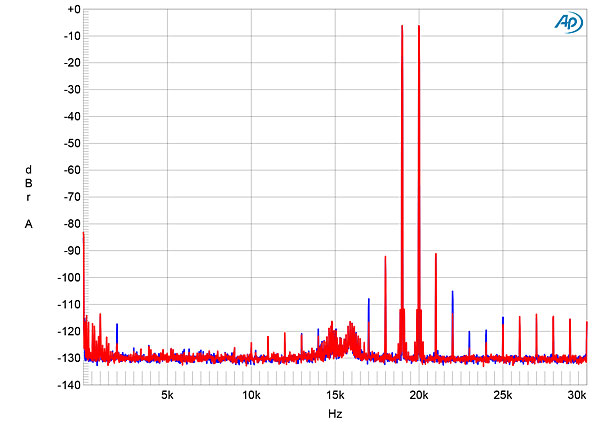
Turning to the Marantz Model 40n's digital-input performance, the optical and coaxial S/PDIF inputs locked to data sampled at up to 192kHz. The Marantz's digital inputs all preserved absolute polarity. With the volume control set to its maximum, a 1kHz digital signal at –40dBFS resulted in a level at both the loudspeaker and headphone outputs of 2.2V. This implies that the D/A circuit has close to 20dB of excess gain. Data at 0dBFS would drive the amplifier into clipping unless the volume control was set to –20dB ("60" on the front-panel display). I used this volume control setting for the digital input measurements, and to avoid damaging the power amplifier stage with high-level digital data, I examined the digital inputs' behavior at the headphone output, which mutes the loudspeaker outputs.
The Marantz amplifier offers a choice of two reconstruction filters, referred to as F1 and F2. F1's impulse response with 44.1kHz data (fig.12) is typical of a very short linear-phase filter, with just one cycle of ringing on either side of the single sample at 0dBFS. F2's impulse response (fig.13) has ringing on both sides of the single high sample, but with considerably more ringing after than before. This impulse response is identical to the "hybrid" filter offered by ESS DAC chips (footnote 1). With 44.1kHz-sampled white noise (fig.14, red and magenta traces), the F1 filter's response rolled off slowly above 20kHz, not reaching full stop-band suppression until 37kHz, well above half the sample rate (vertical green line). The aliased image at 25kHz of a 19.1kHz tone at 0dBFS (blue and cyan traces) is suppressed by just 12dB, therefore, but the distortion harmonics of the 19.1kHz tone are all very low in level. Repeating this analysis with the F2 filter (fig.15), the ultrasonic rolloff was much faster, resulting in considerably greater suppression of the aliased image at 25kHz. However, there is an odd boost in the noisefloor above 65kHz.
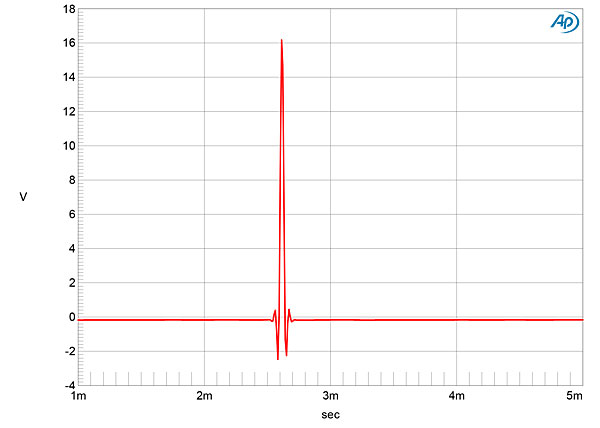
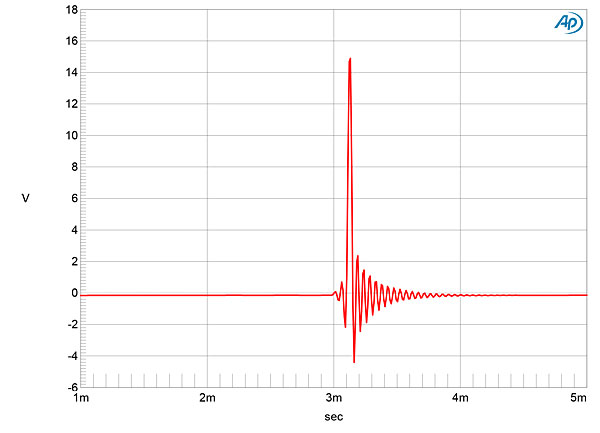
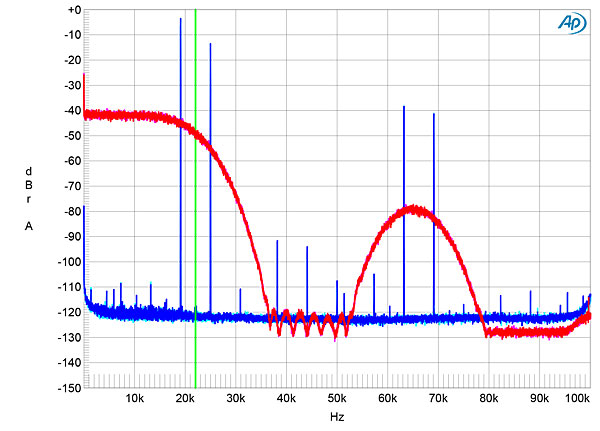
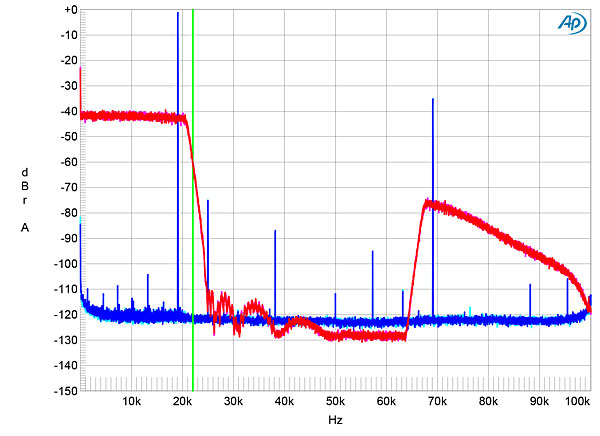
With F1 active and 44.1kHz data (fig.16, green and gray traces), the digital-input frequency response rolled off gently above 12kHz, reaching –3dB at 20kHz. The levels of the two channels were perfectly matched. With 96kHz (cyan, magenta) and 192kHz (blue, red) data, the audioband output was flat, with then a gentle rolloff starting below half of each sample rate. With the F2 filter (fig.17), the audioband response was flat, with then a sharp rolloff just below half of each sample rate.
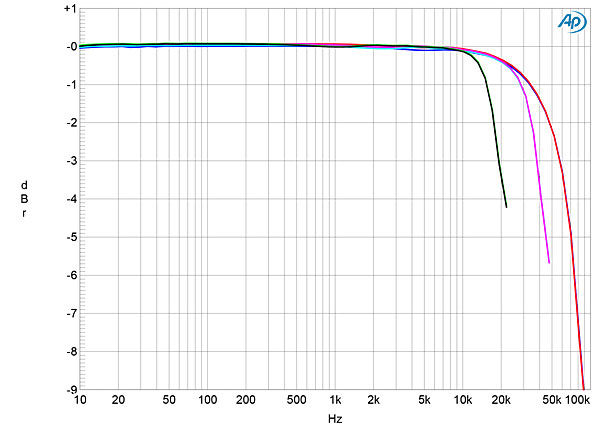

I examined the resolution of the Model 40n's digital inputs by looking at the spectrum at the headphone output with a dithered 1kHz tone at –90dBFS with 16- and 24-bit data (fig.18). The noisefloor dropped by 15dB with 24-bit data, which implies that the Marantz offers between 18 and 19 bits of resolution. However, this graph was taken with the volume control set to –20dB. To examine the ultimate resolution, I repeated the 24-bit analysis with the volume control set to its maximum. The noisefloor dropped by another 6dB, but the improved resolution will be academic given the digital input's gain architecture. The waveform of a tone at exactly –90.31dBFS with undithered 16-bit data was reproduced with the three DC voltage levels described by the data unobscured by noise (fig.19). With undithered 24-bit data (not shown), the result was a relatively clean sinewave.
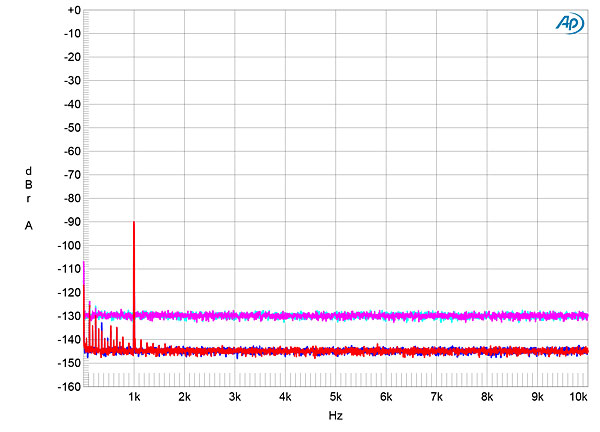
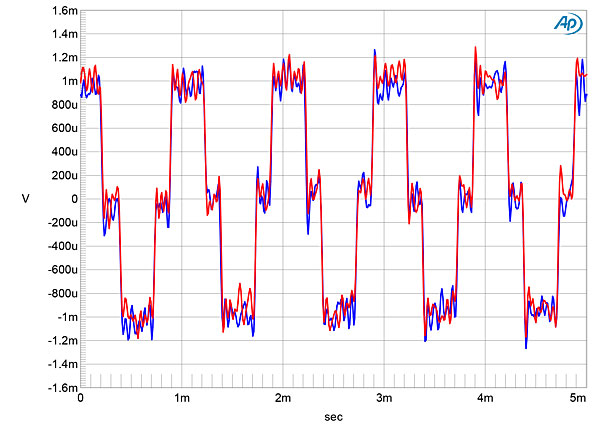
Intermodulation distortion via the Marantz amplifier's digital inputs with F1 active (fig.20) was very low in both channels. While the ultrasonic aliased images of the tones are suppressed by just 10–12dB, the higher-order audioband images all lie close to –120dB. With F2, the difference product at 1kHz lay at just –114dB (0.0002%, fig.21).
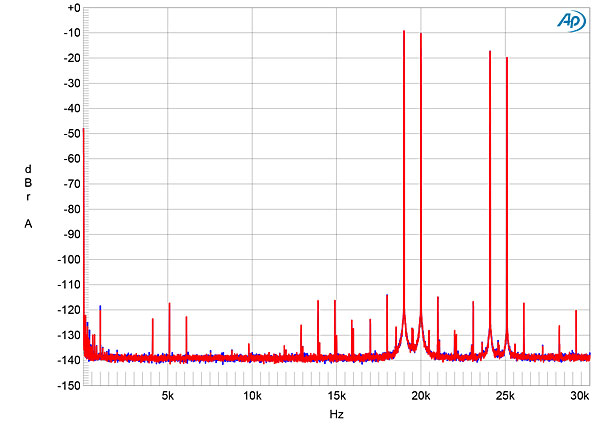
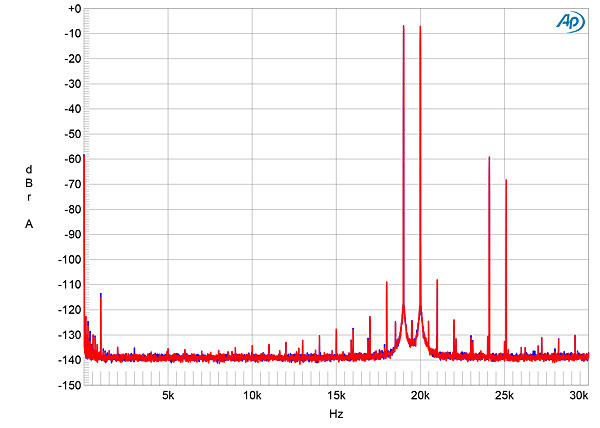
I tested the Model 40n for its rejection of word-clock jitter via its TosLink input using 16- and 24-bit J-Test data sampled at 44.1kHz. Other than those closest to the frequency of the tone at one-quarter the sample rate, the odd-order harmonics of the 16-bit J-Test signal's LSB-level, low-frequency squarewave were all close to the correct levels (fig.22, sloping green line). However, some broadening of the noisefloor around Fs/4 spectral component can be seen, most likely due to jitter with a low-frequency, random noise spectrum. This broadening was also evident with 24-bit J-Test noisefloor data (not shown).
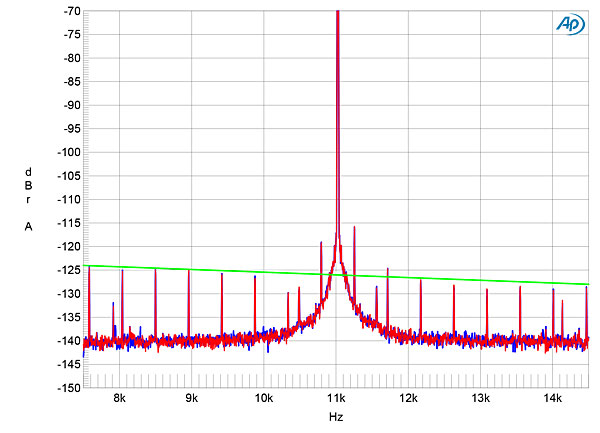
To look at the Marantz's moving magnet phono input, I connected a separate ground wire from the terminal on the amplifier's chassis to the ground of the Audio Precision analyzer. I examined the phono input's behavior primarily at the headphone output, again to avoid damaging the amplifier's output stages with high-level signals.
The phono input preserved absolute polarity. The maximum gain, with the volume control set to its maximum, was 84.8dB at both the headphone output and loudspeaker outputs, so the gain of the phono section is 44.2dB. This gain value means that clipping is possible with high-level LP signals; owners should make sure the volume control isn't set near the maximum when using the phono input. I performed most of the phono-input tests with the control set to –20dB. (The exception was the overload testing, when I reduced the control by another 20dB to make sure I was looking at input overload rather than output clipping.)
The M40n's phono input impedance was 39k ohms at 20Hz, 46k ohms at 1kHz, and 40k ohms at 20kHz, values appropriate for moving magnet cartridges. The RIAA correction (fig.23) was well-matched between the channels but featured a broad rise in the midrange that reached +0.45dB at 150Hz. The phono input's unweighted, wideband S/N ratio, measured with the input shorted to ground, was a very good 69.7dB (average of both channels) referred to an input signal of 1kHz at 5mV. Restricting the measurement bandwidth to 22Hz–22kHz increased the ratio to an excellent 83dB, while switching an A-weighting filter into circuit further increased the ratio to 87.7dB.
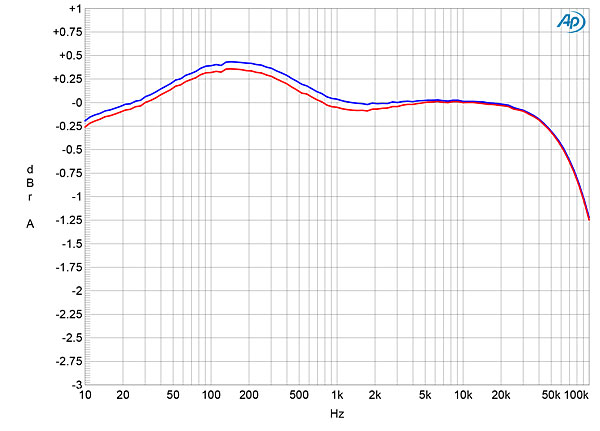
The Marantz phono input's overload margins were commendably high from 20Hz to 20kHz, at 24.4dB ref. 1kHz at 5mV. The phono stage's distortion was very low, with all the second and third harmonics lying close to –100dB (0.001%, fig.24), even with a 1kHz tone 16dB higher than the nominal MM output level of 5mV. High-order intermodulation distortion with an equal mix of 19kHz and 20kHz tones, at a peak input level equivalent to 1kHz at 30mV, lay below –100dB (not shown), with the second-order difference product at 1kHz lying at –94dB (0.003%).
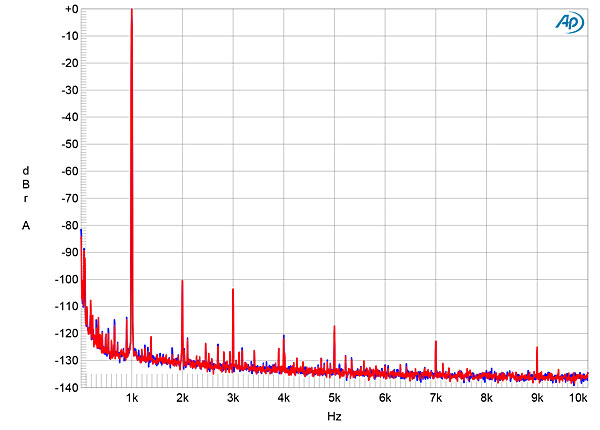
The Marantz Model 40n offers uniformly excellent measured performance from all its inputs. But I remain puzzled why its digital inputs, in common with almost all integrated amplifiers I have tested, offer considerably higher gain than necessary.—John Atkinson

and your comment is so .......... ironic. :-)

I understand your comment and, to be clear, I found Heos to be excellent only in the context of the Marantz 40n ("its intended network implementation") and in comparison to the alternatives provided by 40n. I am not a fan of proprietary streaming products such as Heos and BlueOS.

Hi
HDMI-ARC is for sound of the TV programmes sending back to the amp. We know how 'good' TV sound can be. I won't lose sleep on it.
Listening is believing
Jack L

... for providing measurements for the tone controls. This is yet another Marantz amplifier that I refuse to buy because of their goofy, stupid implementation of their tone controls. For 95 percent of my listening I do NOT use them, but when I do it's important that they get them right. Take a look at Stereophile's review of the Outlaw Audio RR2160 receiver -- THAT's how you implement tone controls, Marantz! Do it, and I'll buy one of your amplifiers.

they were introduced-
they have that "in dash" car stereo look, as in a '79 Trans Am dash!

they were introduced-
they have that "in dash" car stereo look, as in a '79 Trans Am dash!

I have a Marantz product that I like very much--except for the porthole display. It doesn't give enough information, and it's essentially an eye test unless you sit close to your equipment.

It is a semi-intelligent power indicator, mostly useful for set-up.

I am a fan of Marantz products and have both one of their amps (bit upmarket of this) and their SACD player. This product however makes me cringe: first, the last thing I would want is to be UNNECESSARILY radiated in my own lounge or music room by wi-fi radiation, when a simple cable will do the job vastly better, without compression or loss. Second, the entire concept of using Bluetooth, which is almost always compressed and lossy, is the very antithesis of hi-fi and makes a mockery of the product. I am yet to meet a hi-fi enthusiast so cheap that they cannot afford 5m of cable, or who does not even enjoy in the selecting of same.

The beauty of hi-fi equipment has traditionally been its longevity: I know people with amps or turntables from 20 years ago that are still performing brilliantly, look superb, and attract wows. How long do you think an amp that requires an app is going to last? How long and how well have Marantz's previous network integrated components lasted before they have become outdated?

Well said, Wozwoz. I have a DAC/Universal Music Controller that I bought in 2013. Less than a year later, an iOS update rendered the app obsolete. While I can still use the device with its handheld remote, I’ve lost significant functionality that the app provided. I now avoid devices that rely on manufacturer or closed-system apps for desired use since there will eventually be an app or OS update that will render it useless.